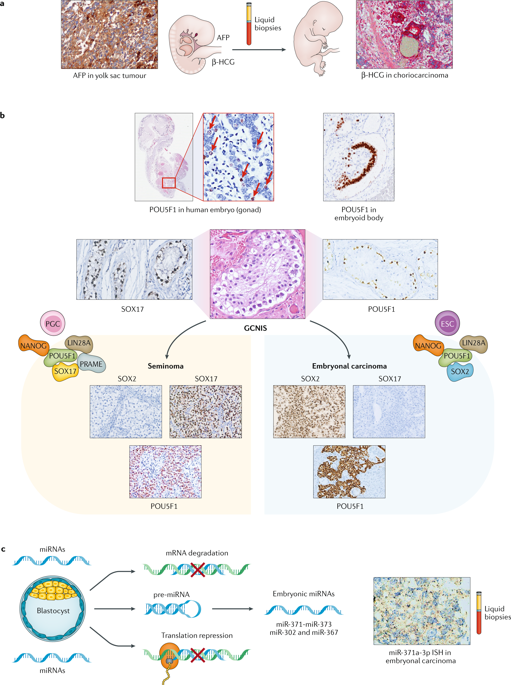当前位置:
X-MOL 学术
›
Nat. Rev. Urol.
›
论文详情
Our official English website, www.x-mol.net, welcomes your
feedback! (Note: you will need to create a separate account there.)
Application of miRNAs in the diagnosis and monitoring of testicular germ cell tumours.
Nature Reviews Urology ( IF 12.1 ) Pub Date : 2020-03-10 , DOI: 10.1038/s41585-020-0296-x Kristian Almstrup 1, 2 , João Lobo 3, 4 , Nina Mørup 1, 2 , Gazanfer Belge 5 , Ewa Rajpert-De Meyts 1, 2 , Leendert H J Looijenga 4 , Klaus-Peter Dieckmann 6
Nature Reviews Urology ( IF 12.1 ) Pub Date : 2020-03-10 , DOI: 10.1038/s41585-020-0296-x Kristian Almstrup 1, 2 , João Lobo 3, 4 , Nina Mørup 1, 2 , Gazanfer Belge 5 , Ewa Rajpert-De Meyts 1, 2 , Leendert H J Looijenga 4 , Klaus-Peter Dieckmann 6
Affiliation

|
Testicular germ cell tumours (TGCTs) are the most frequent cancer type in young men and originate from the common precursor germ cell neoplasia in situ (GCNIS). For decades, clinical management of patients with TGCT has relied on classic serum tumour markers: α-fetoprotein, human chorionic gonadotropin subunit-β and lactate dehydrogenase. In the past 10 years, microRNAs have been shown to outperform classic serum tumour markers in the diagnosis of primary tumours and in follow-up monitoring and prediction of relapse. miR-371a-3p is the most consistent marker and exhibits >90% diagnostic sensitivity and specificity in TGCT. However, miR-371a-3p cannot be used to diagnose GCNIS or mature teratoma. Future efforts must technically standardize the microRNA-based methods internationally and introduce miR-371a-3p as a molecular liquid biopsy-based marker for TGCTs in the clinic.
中文翻译:

miRNA在睾丸生殖细胞肿瘤的诊断和监测中的应用。
睾丸生殖细胞肿瘤(TGCT)是年轻男性中最常见的癌症类型,起源于常见的前体生殖细胞原位肿瘤(GCNIS)。数十年来,TGCT患者的临床治疗一直依靠经典的血清肿瘤标志物:α-甲胎蛋白,人绒毛膜促性腺激素亚基-β和乳酸脱氢酶。在过去的十年中,在原发性肿瘤的诊断以及随访监测和复发预测中,microRNA已显示出优于经典的血清肿瘤标志物。miR-371a-3p是最一致的标记,在TGCT中显示> 90%的诊断敏感性和特异性。但是,miR-371a-3p不能用于诊断GCNIS或成熟的畸胎瘤。
更新日期:2020-03-10
中文翻译:

miRNA在睾丸生殖细胞肿瘤的诊断和监测中的应用。
睾丸生殖细胞肿瘤(TGCT)是年轻男性中最常见的癌症类型,起源于常见的前体生殖细胞原位肿瘤(GCNIS)。数十年来,TGCT患者的临床治疗一直依靠经典的血清肿瘤标志物:α-甲胎蛋白,人绒毛膜促性腺激素亚基-β和乳酸脱氢酶。在过去的十年中,在原发性肿瘤的诊断以及随访监测和复发预测中,microRNA已显示出优于经典的血清肿瘤标志物。miR-371a-3p是最一致的标记,在TGCT中显示> 90%的诊断敏感性和特异性。但是,miR-371a-3p不能用于诊断GCNIS或成熟的畸胎瘤。











































 京公网安备 11010802027423号
京公网安备 11010802027423号